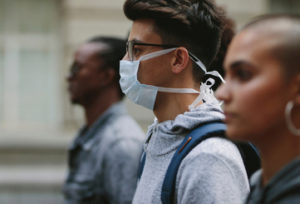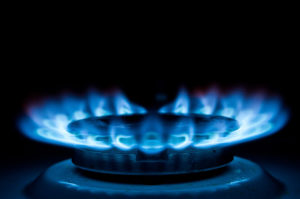This summer, as a record number of uncontained wildfires burned along the West Coast, residents feverishly checked websites such as PurpleAir to determine if it was safe to go outside. Every year, wildfires raise awareness about the impacts of poor air quality on human health. And every year, once the smoke and ash clear, many people return to assuming their air is safe to breathe.
 The reality is more than 21.2 million Americans live in counties with unhealthy levels of year-round particulate pollution, according to the latest “State of the Air” report. Long-term exposure to unhealthy air can trigger respiratory problems, which can compound other health symptoms such as those resulting from COVID-19.
The reality is more than 21.2 million Americans live in counties with unhealthy levels of year-round particulate pollution, according to the latest “State of the Air” report. Long-term exposure to unhealthy air can trigger respiratory problems, which can compound other health symptoms such as those resulting from COVID-19.
Just as concerning, and just as pervasive, is the indoor air pollution resulting from residential gas appliances — which are known to contribute pollution to outdoor air as well. Increased awareness about the lasting health impacts resulting from prolonged exposure to gas appliances, along with mounting concern over climate change, has led a growing number of jurisdictions to consider policies that favor building electrification – a term referring to all-electric, energy-efficient homes and other buildings that are often powered by renewable energy.
Electrification is growing in popularity because it has the potential to mitigate health and environmental risks caused by fossil fuel-based power, save consumers money in the long run, and enable better grid-building management during times of peak energy use. It is critical to ensure every member of our society has equal access to, and benefits from, building electrification. Here are some considerations for jurisdictions considering electrification policies.
Why indoor gas pollution is a serious health risk
A growing body of research suggests fossil-fuel burning appliances such as stoves and ovens release pollutants, including: nitrogen dioxide (NO2), sulfur dioxide (SO2), carbon monoxide (CO), nitric oxide (NO), fine particulate matter (PM2.5), ultrafine particles (UFP), formaldehyde, and acetaldehyde. NO2 emissions resulting from gas cooking are especially dangerous as they tend to surpass national indoor air quality guidelines and even outdoor standards. A 2020 UCLA report focused on California found that acute and chronic consequences from exposure to these toxins range from decreased lung function, asthma exacerbation, stroke and death, to lung and breast cancer, brain and heart toxicity, and premature mortality.
Children are at an even greater risk to pulmonary and cardiovascular illness, according to a study by Rocky Mountain Institute. This is because they have higher breathing rates and greater levels of physical activity, higher lung surface to body weight ratios, and immature respiratory and immune systems. Exposure to high levels of NO2 increases children’s risk of asthma by 42%.
 Indoor pollution has economic consequences as well. A study by the Centers for Disease Control and Prevention (CDC) estimated that asthma costs the U.S. more than $80 billion per year in medical care, absenteeism, and mortality. This weighs heavily on low-income communities where people are more likely to be living in households with inefficient gas equipment and less likely to seek medical care due to cost and other accessibility barriers. Low-income households are also more likely to use gas appliances as heat sources during cold weather, increasing the chance of exposure to indoor pollutants,
Indoor pollution has economic consequences as well. A study by the Centers for Disease Control and Prevention (CDC) estimated that asthma costs the U.S. more than $80 billion per year in medical care, absenteeism, and mortality. This weighs heavily on low-income communities where people are more likely to be living in households with inefficient gas equipment and less likely to seek medical care due to cost and other accessibility barriers. Low-income households are also more likely to use gas appliances as heat sources during cold weather, increasing the chance of exposure to indoor pollutants,
There is also the added consideration of public safety issues and economic consequences of outdated gas infrastructure. Pipelines are responsible for safety incidents, injuries and fatalities, and are vulnerable to natural catastrophes. In 2005 after Hurricane Katrina, the reported cost to repair the natural gas system in New Orleans was $470 million. Since 2010, gas pipelines have cost the U.S. $198 million annually in damages. Leaks also pose a health risk to residents because they can release tons of noxious gas into air, and historically have forced residents to evacuate.
Ensuring affordability and equity in electrification
More than 30 cities in California have adopted some form of electrification codes. As more communities look at developing electrification policies, it’s crucial that decision makers take steps to understand the costs and benefits of building electrification to low-income residents, communities of color, and other underrepresented populations. This means engaging with diverse stakeholders and partners, especially those who have been actively working to address environmental and social justice issues, so that unintended consequences such as displacement and gentrification are avoided.
As more communities look at developing electrification policies, it’s crucial that decision makers take steps to understand the costs and benefits of building electrification to low-income residents, communities of color, and other underrepresented populations.
For more than two decades, New Buildings Institute (NBI) has been working with jurisdictions and other partners to develop and support building codes that lead to energy savings and carbon emissions reduction. In recent years, we’ve assisted cities with the creation of code and policy language that incentivizes or requires electrification. Building performance standards (BPS) are one of the tools available to cities and states to address the carbon emissions and energy use of existing buildings while also including metrics for public health and equity.
While the health benefits are clear, the upfront costs associated with swapping fossil-fueled appliances with all-electric alternatives — mainly in existing buildings — is significant and often out of reach for low-income families and people of color. These families consistently carry a high energy burden because of typically poor energy performance in affordable housing that drives up energy bills. Jurisdictions calling for electrification need to be working toward an equal playing field through these policies, not worsen the burden on vulnerable populations.
In a later blog we will dive deeper into the issues surrounding electrification and affordability, including some of the options jurisdictions have to address the upfront costs associated with this transition.
by Maurissa Brown, NBI RAY Clean Energy Diversity Fellow
Bio
